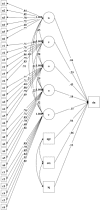Personality and complex brain networks: The role of openness to experience in default network efficiency
- PMID: 26610181
- PMCID: PMC4738373
- DOI: 10.1002/hbm.23065
Personality and complex brain networks: The role of openness to experience in default network efficiency
Abstract
The brain's default network (DN) has been a topic of considerable empirical interest. In fMRI research, DN activity is associated with spontaneous and self-generated cognition, such as mind-wandering, episodic memory retrieval, future thinking, mental simulation, theory of mind reasoning, and creative cognition. Despite large literatures on developmental and disease-related influences on the DN, surprisingly little is known about the factors that impact normal variation in DN functioning. Using structural equation modeling and graph theoretical analysis of resting-state fMRI data, we provide evidence that Openness to Experience-a normally distributed personality trait reflecting a tendency to engage in imaginative, creative, and abstract cognitive processes-underlies efficiency of information processing within the DN. Across two studies, Openness predicted the global efficiency of a functional network comprised of DN nodes and corresponding edges. In Study 2, Openness remained a robust predictor-even after controlling for intelligence, age, gender, and other personality variables-explaining 18% of the variance in DN functioning. These findings point to a biological basis of Openness to Experience, and suggest that normally distributed personality traits affect the intrinsic architecture of large-scale brain systems. Hum Brain Mapp 37:773-779, 2016. © 2015 Wiley Periodicals, Inc.
Keywords: default mode network; individual differences; network science; personality; structural equation modeling.
© 2015 The Authors Human Brain Mapping Published by Wiley Periodicals, Inc.
Figures


References
-
- Alavash M, Doebler P, Holling H, Thiel CM, Gießing C (2015): Is functional integration of resting state brain networks an unspecific biomarker for working memory performance? Neuroimage 108:182–193. - PubMed
-
- Arendasy M, Sommer M, Feldhammer M (2011): Manual Big‐Five Structure Inventory BFSI. Schuhfried Gmbh Mödling.
Publication types
MeSH terms
LinkOut - more resources
Full Text Sources
Other Literature Sources

